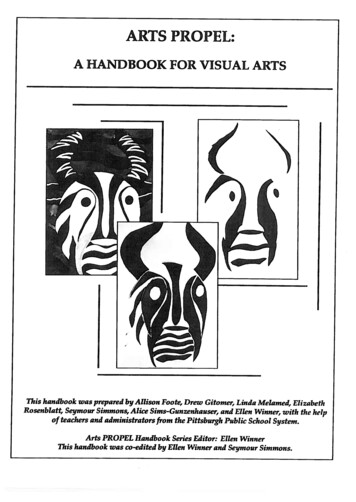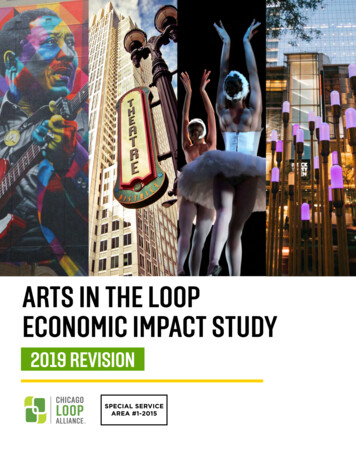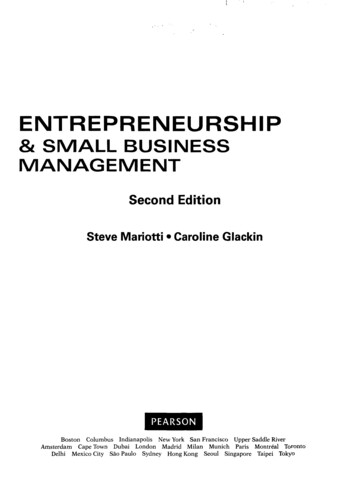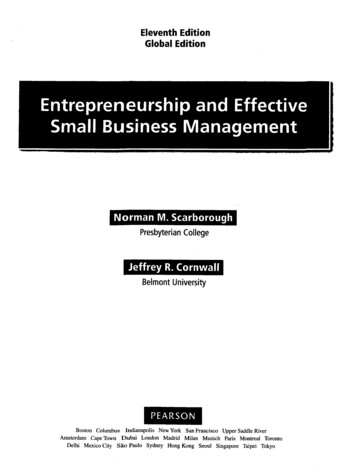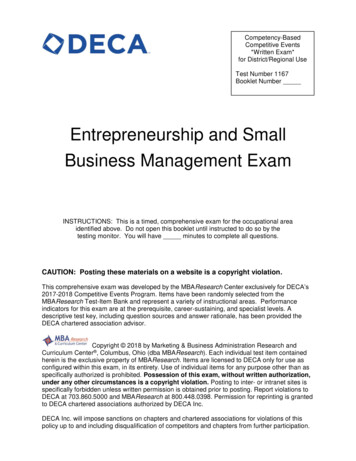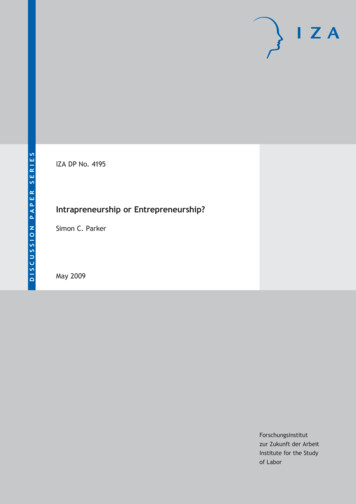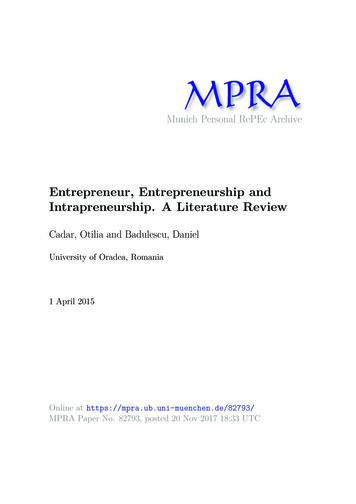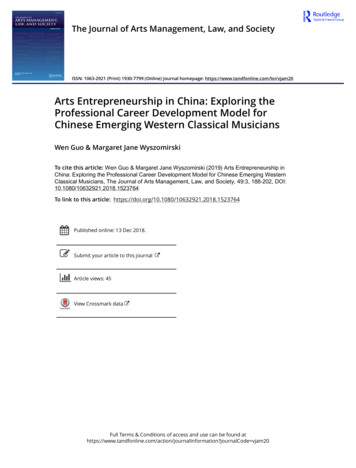
Transcription
The Journal of Arts Management, Law, and SocietyISSN: 1063-2921 (Print) 1930-7799 (Online) Journal homepage: https://www.tandfonline.com/loi/vjam20Arts Entrepreneurship in China: Exploring theProfessional Career Development Model forChinese Emerging Western Classical MusiciansWen Guo & Margaret Jane WyszomirskiTo cite this article: Wen Guo & Margaret Jane Wyszomirski (2019) Arts Entrepreneurship inChina: Exploring the Professional Career Development Model for Chinese Emerging WesternClassical Musicians, The Journal of Arts Management, Law, and Society, 49:3, 188-202, DOI:10.1080/10632921.2018.1523764To link to this article: shed online: 13 Dec 2018.Submit your article to this journalArticle views: 45View Crossmark dataFull Terms & Conditions of access and use can be found ation?journalCode vjam20
THE JOURNAL OF ARTS MANAGEMENT, LAW, AND SOCIETY2019, VOL. 49, NO. 3, 3764Arts Entrepreneurship in China: Exploring the ProfessionalCareer Development Model for Chinese Emerging WesternClassical MusiciansWen Guo and Margaret Jane WyszomirskiOhio State University, Columbus, OhioABSTRACTArtists’ career management has become an urgent topic in thescholarship of arts administration and the creative economy in manyWestern countries. Although Chinese creative and cultural industrieshave also experienced significant attention and growth, the worklifeexperiences of Chinese cultural workers are rarely discussed in theinternational academic literature. Addressing that gap, this studyinvestigates artistic careers and professional development of a smallsample of emerging Western classical musicians in a Chinesesecond-tier city. We found similar patterns in career portfolios andstrategies of career entrepreneurship between Western and Chinesemusicians, although differing career opportunities and explicit careerstrategies seem related to local context.KEYWORDSArts entrepreneurship;career strategy; Chineseclassical musicians; portfoliocareer; venture creationExisting literature on worklife and career paths of artists is based on the assumptionand logic that are grounded in the Western institutional and cultural underpinnings.This article attempts to build connections between the prevailing knowledge onWestern artists’ careers and the less-studied Chinese artists’ career trajectory by adapting the arts entrepreneurship theory of Ruth Bridgstock (2013) to a Chinese context.With a focus on the burgeoning concept of arts entrepreneurship, the article also introduces the impact of the immense political and social change in Chinese society, whileportraying Chinese emerging musicians as a new generation of Chinese arts entrepreneurs under the theoretical framework of Bridgstock. The comparison between the career entrepreneurial experience of Western and Chinese emerging artists addresses thegap in Chinese arts administration studies and takes the Chinese national context intoaccount as a means to examine the generalizability of the theory and situate the theoryconstruction of arts entrepreneurship in global circumstances.Career development of artists: Literature overviewNotable Western studies on the career development of artists have been undertaken inthe United Kingdom, in Australia, and in the United States. Many of these studies haveexamined artist careers across art disciplines including visual artists, writers, designers,CONTACT Wen Guoguo.434@buckeyemail.osu.eduOhio State University, Arts Administration, Education andPolicy, 231 Sullivant Hall, 1813 N. High St., 2nd Floor, Columbus, OH 43210, USA.ß 2018 Taylor & Francis Group, LLC
THE JOURNAL OF ARTS MANAGEMENT, LAW, AND SOCIETY189musicians, dancers, and actors (among others). Frequently, such studies involve largesurvey samples conducted on a national level (e.g., Strategic National Arts AlumniProject, 2012, 2013; Cunningham et al. 2010; Ball, Pollard, and Stanley 2010). There arealso smaller localized studies (e.g., Dance/NYC 2007; Lendel et al. 2011). Alternatively,other studies have focused on artists in a single art form, even a specific genre withinan art form (e.g., Jeffri and Throsby 2006; Jeffri and NEA 2003). While many studiesinvolve survey research, others employ a more qualitative approach to understandingthe “artworlds” (Becker 1976, 1982) in which artists pursue their careers and explorethe many intermediaries and structures that influence artist careers. Many smaller casestudies of artist worklife and careers have gathered information via personal interviewswith small samples (e.g., Umney and Kretsos 2014; Martin 2007). Musicians, being oneof the largest artist occupations and one with many well-established sub-specializations,have been the subject of numerous studies, large and small, national and local, quantitative and qualitative (e.g., Faulkner 1973; Burland 2005; Dobrow 2006).A few generalizations emerge from the wide range of research on artist careers andworklife, and are broadly applicable to professional musicians—and will be explored inthe discussion of our study: Full-time jobs are not the norm for most artists. Rather, artists’ careers involvepart-time work and self-employment (e.g., Bridgstock 2009).Many artists work in arts occupations both within and outside arts organizations,as well as in non-arts jobs outside of arts organizations (e.g., Throsby 1994).Many artists work in multiple arts-related occupations beyond creation and/orperformance, such as arts education, arts management, criticism, and suppliesand equipment (e.g., Lingo and Tepper 2013; Ball, Pollard, and Stanley 2010).Many artists find artistic work in various sectors of the economy—commercial,nonprofit, government, and community (e.g., Markusen 2006).Artists are apt to pursue self-employment and portfolio careers. Currently, theycan live and work in all types of communities (e.g., Markusen 2013).Many, if not most, professionally trained classical musicians regard their idealjob to be a full-time position within a professional orchestra (e.g., Bennett 2008;Munnelly 2017).Recognition of the pervasiveness of these patterns has led to recent interest in howartists form and manage such portfolio careers. On the one hand, this interest hasframed the self-development of the artist career as a form of arts entrepreneurship(Bridgstock 2013; Beckman 2007; Chang and Wyszomirski 2015). Concurrently, thespread of concepts like creative industries, creative economy, and creative cities hasrevealed that the opportunity to construct portfolio careers is now possible for moreartists in more locations than has historically been the case.On the other hand, the literature has paid considerable attention to discussingwhether and to what extent artist education and training provide them with the necessary skills and competencies to manage such portfolios in order to maintain a lifestyleof “flexicurity” (Murray and Gollmitzer 2012) — which is a condition with a stableincome for living and a flexible schedule for creative production. Such flexicurity is
190W. GUO AND M. J. WYSZOMIRSKIproposed as an alternative to the “financial insecurity, unsociable hours, injury and lackof practitioner diversity” characteristic of the precarious career trajectory of workingartists (Bennett 2008, 121).Our purpose is to provide insight into the relevancy of the Western-based literatureto a local Chinese context by understanding the career development experiences of tenChinese classical musicians. Thus, we look at similarities and differences that theChinese experiences display in comparison to the aforementioned patterns generalizedfrom Western-based research regarding artist worklife and career development. In addition, we elaborate on the comparison by analyzing a revealing localized case where theinterviewed musicians were pursuing professional careers in a second-tier Chinese city.1The rapid growth of second-tier Chinese cities with first-class potential is making it amore common site for emerging artists but a context that is notably understudied inacademic research on Chinese cultural policy and creative industries. With 7.8 percentof Chinese total population, 20.7 percent of GDP of China, and 18.8 percent of Chinesetotal consumption capacity (National Bureau of Statistics of China 2016), the secondtier cities provide alternative facilities, sophisticated consumers, and cultural ethos thatbegin to resemble those of major urban arts centers like Shanghai, Beijing, andGuangzhou. In addition, governments of Chinese second-tier cities also invest heavily intheir creative cultural industries with both financial and policy support spurred by thecreative cultural policy of the Chinese central government. These rising second-tier cities seek to offer new opportunities for Chinese artists to make a living and develop successful careers away from cities long perceived as Chinese arts capitals. Nevertheless,cultural scenes and artists in these second-tier cities rarely appear in English research.Such a local perspective allows us to explore how context may influence the opportunities for the assembly of portfolio careers according to the three approaches to arts entrepreneurship proposed by the Australian scholar Bridgstock (2013); namely,employability, enterprising dispositions, and venture creation.Having been introduced in China more than two centuries ago, Western classicalmusic—including symphony orchestra, chamber music, opera, ballet, etc.—has beendeemed by the Chinese government to be a cultural indicator of an advanced civilization and a diplomatic language that is useful in communicating with the Western world(Melvin and Cai 2004). Although Chinese audiences still have a narrow understandingand limited access to the Western tradition of classical music, a domestic market forclassical music and a value chain around it have been created under a series of Chineseeconomic, educational and cultural reforms over the past three decades. Nevertheless,the Chinese context is not as fully developed as the situation in the West, where theorchestral genre and institution originated. Over the past two to three centuries, theorchestra industry of many Western countries has built mature markets, extensive workforce training systems, widespread production systems, and effective infrastructures,particularly regarding concert venues, relevant cultural facilities, and financial supportsystems. Currently, Western professional classical musicians are challenged by the overall diminished popularity of classical music (National Endowment for the Arts 2015;American Symphony Orchestra League 1993). In contrast, Chinese professional classicalmusicians are exploring their career possibilities in an underdeveloped, but promising,domestic classical music market with a plethora of newly built grand theaters (Melvin
THE JOURNAL OF ARTS MANAGEMENT, LAW, AND SOCIETY1912012). In this market where the best orchestras have not “come close to match theworld’s best in power, beauty and precision” (The Economist 2016), both professionalism and entrepreneurialism are developing simultaneously among a new generation ofmusicians. The following research analysis seeks to explore the professional identities ofChinese local professional classical musicians and understand their everyday experienceas arts entrepreneurs situated in the nexus of place, cultural policies, and Chinese socialchange of the past three decades.Research methodologyIn order to obtain a bottom-up perspective on the career development experiences ofChinese classical musicians, we conducted semi-structured interviews with ten selectedemerging local musicians in a second-tier city, Wuxi, in Jiangsu Province between May13 and May 27, 2015. Wuxi is a representative second-tier city in one of the wealthiestprovince in China: Jiangsu. In comparison with cultural hubs like Shanghai and Beijing,which are supported by top-notch artists, Wuxi, as a common second-tier city withouta well-known contemporary cultural identity, offers an alternative site to observe theworklife style of Chinese emerging artists. The focus on emerging classical musiciansreflects our interest in learning about artists in the process of developing their professional careers. Field notes and archived data, including academic literature, newsreports, and government documents, were collected as additional data to contextualizethe interview responses. This location was selected due to its less-developed classicalmusic “industry” in comparison to first-tier cities with more mature classicalmusic markets.The research employed a non-probabilistic purposive sampling method, with whichten musicians were recruited for a two-hour semi-structured interview each. The following three-part selection criteria was used: Age: between 24 to 40 years old living in Wuxi, Jiangsu Province;Education: hold a Bachelor’s degree or above in majors relevant to classicalmusic, including music performance, music composition, music education, musicconducting, recording engineering, musicology, music history or other relatedmajors, from either Chinese or foreign higher education institutions;Professional Status & Earnings: primarily rely on their professional credentials,artistic skills, and music relevant knowledge to make a living.Although an interview sample of ten respondents is small, it can be sufficient for ourpurposes. The population of professional Western classical musicians in China is verysmall and the same population outside the major cultural centers mentioned earlier iseven smaller. In the absence of useful local workforce figures and national figures thatoften do not distinguish among types of musicians, we consulted with a local contactfor this study—a local music teacher and performer who is well-connected to classicalmusicians in Wuxi and its surrounding area. Understanding the purpose of the re
Chinese Emerging Western Classical Musicians Wen Guo & Margaret Jane Wyszomirski To cite this article: Wen Guo & Margaret Jane Wyszomirski (2019) Arts Entrepreneurship in China: Exploring the Professional Career Development Model for Chinese Emerging Western Classical Musicians, The Journal of Arts Management, Law, and Society, 49:3, 188-202, DOI: 10.1080/10632921.2018.1523764

